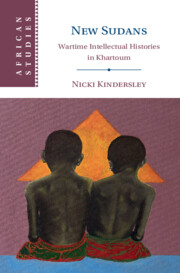400 results
4 - Ireland’s Accession to the League of Nations
-
- Book:
- An International Anomaly
- Published online:
- 23 March 2025
- Print publication:
- 03 April 2025, pp 125-178
-
- Chapter
-
- You have access
- Open access
- HTML
- Export citation
Opportunistic rebel tactics in civil war: Evidence from Colombia
-
- Journal:
- Political Science Research and Methods , First View
- Published online by Cambridge University Press:
- 20 March 2025, pp. 1-19
-
- Article
-
- You have access
- Open access
- HTML
- Export citation
Chapter 2 - Thrasybulus and the Democratic Resistance
-
- Book:
- Athens, 403 BC
- Published online:
- 28 February 2025
- Print publication:
- 20 March 2025, pp 71-95
-
- Chapter
-
- You have access
- HTML
- Export citation
Chapter 10 - Lysias, a Multifaceted Man
-
- Book:
- Athens, 403 BC
- Published online:
- 28 February 2025
- Print publication:
- 20 March 2025, pp 251-296
-
- Chapter
- Export citation
Chapter 1 - Critias and the Oligarchs
-
- Book:
- Athens, 403 BC
- Published online:
- 28 February 2025
- Print publication:
- 20 March 2025, pp 31-70
-
- Chapter
- Export citation
Chapter 16 - Political Poetics: Intercrossing Discourses and American Belonging
- from Part III - Genres
-
-
- Book:
- The Cambridge Companion to Nineteenth-Century American Literature and Politics
- Published online:
- 06 March 2025
- Print publication:
- 13 March 2025, pp 271-288
-
- Chapter
- Export citation
6 - Catharsis and Conclusion
-
- Book:
- Gendering Secession
- Published online:
- 06 March 2025
- Print publication:
- 13 March 2025, pp 186-203
-
- Chapter
- Export citation
7 - Military Independence and Khartoum’s Warlord Communities
-
- Book:
- New Sudans
- Published online:
- 06 February 2025
- Print publication:
- 13 February 2025, pp 263-287
-
- Chapter
- Export citation
Do the Lights Stay on? Deployment and Withdrawal of Peacekeepers and Their Effect on Local Economic Development
-
- Journal:
- British Journal of Political Science / Volume 55 / 2025
- Published online by Cambridge University Press:
- 13 February 2025, e25
-
- Article
-
- You have access
- Open access
- HTML
- Export citation
Chapter 6 - Social and Political Thinker
-
- Book:
- The Cambridge Introduction to Samuel Johnson
- Published online:
- 07 February 2025
- Print publication:
- 13 February 2025, pp 96-113
-
- Chapter
- Export citation
8 - Return to the South, 2005–2011
-
- Book:
- New Sudans
- Published online:
- 06 February 2025
- Print publication:
- 13 February 2025, pp 288-304
-
- Chapter
- Export citation

New Sudans
- Wartime Intellectual Histories in Khartoum
-
- Published online:
- 06 February 2025
- Print publication:
- 13 February 2025
4 - First Ladies in Wartime
-
-
- Book:
- The Cambridge Companion to US First Ladies
- Published online:
- 02 January 2025
- Print publication:
- 06 February 2025, pp 70-97
-
- Chapter
- Export citation
Chapter 2 - Frances Ellen Watkins Harper and the New Civil War Literary Studies
-
-
- Book:
- The New Nineteenth-Century American Literary Studies
- Published online:
- 02 January 2025
- Print publication:
- 23 January 2025, pp 24-38
-
- Chapter
- Export citation
Chapter 3 - The Global South
-
-
- Book:
- The New Nineteenth-Century American Literary Studies
- Published online:
- 02 January 2025
- Print publication:
- 23 January 2025, pp 39-52
-
- Chapter
- Export citation
2 - The Impact of Violence on Relationships
-
- Book:
- Love and Violence in Sierra Leone
- Published online:
- 28 January 2025
- Print publication:
- 23 January 2025, pp 42-58
-
- Chapter
-
- You have access
- Open access
- HTML
- Export citation
7 - Communal Peace
- from Part II - Applying the Theory to a Case Study: Mali
-
- Book:
- Local Peace, International Builders
- Published online:
- 02 January 2025
- Print publication:
- 16 January 2025, pp 156-166
-
- Chapter
-
- You have access
- Open access
- Export citation
8 - International Peace
- from Part III - Implications for Academics and Policymakers
-
- Book:
- Local Peace, International Builders
- Published online:
- 02 January 2025
- Print publication:
- 16 January 2025, pp 169-176
-
- Chapter
-
- You have access
- Open access
- Export citation
Rethinking rebel victory in civil war
-
- Journal:
- Review of International Studies , First View
- Published online by Cambridge University Press:
- 07 January 2025, pp. 1-19
-
- Article
- Export citation
The Determinants of Insurgent Gender Governance
-
- Journal:
- International Organization / Volume 79 / Issue 1 / Winter 2025
- Published online by Cambridge University Press:
- 12 March 2025, pp. 36-80
- Print publication:
- Winter 2025
-
- Article
-
- You have access
- Open access
- HTML
- Export citation


